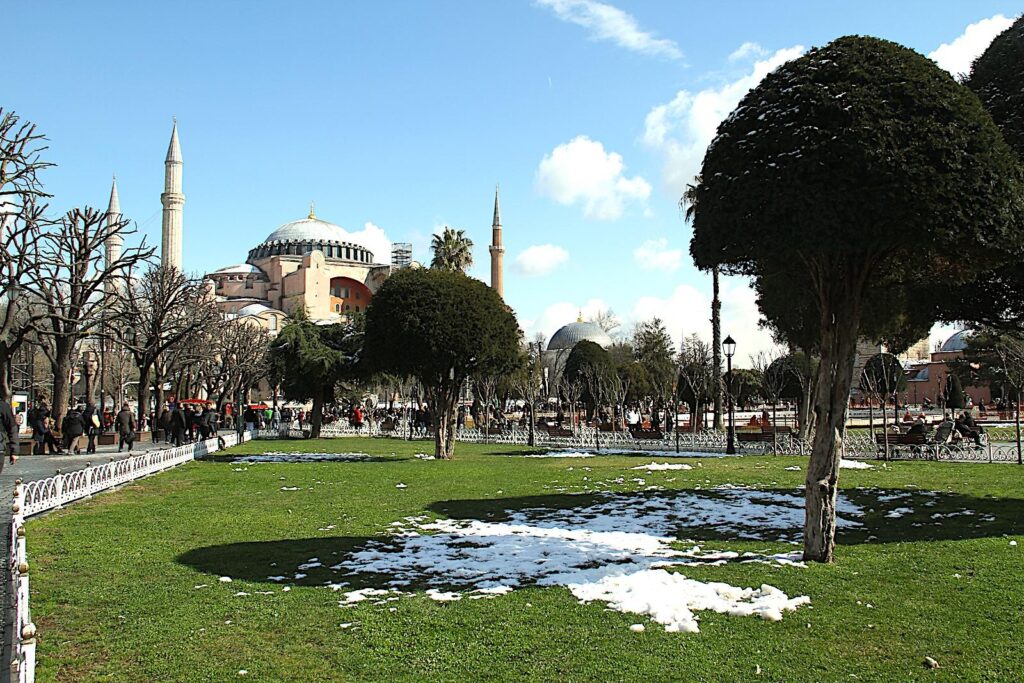Türkiye weather and its climate exhibit significant regional variations due to its diverse topography and geographical location. Coastal areas along the Mediterranean and Aegean Seas experience a Mediterranean climate characterised by hot, dry summers and mild, rainy winters. In contrast, the Black Sea coast has a temperate oceanic climate with warm summers, mild winters, and consistent yearly rainfall. The interior Anatolian plateau falls under a continental climate marked by hot, dry summers and cold, snowy winters, with substantial temperature fluctuations between seasons.
The surrounding seas, mountain ranges, and proximity to different air masses contribute to this climatic diversity. The Black Sea’s moisture-laden air results in higher precipitation, while the mountainous terrain creates microclimates with varying temperatures and rainfall patterns. The transition from coastal to inland areas leads to a gradual shift from maritime to continental influences, resulting in a wide range of climatic conditions across Türkiye.
The average climate information below is based on data from the Turkish State Meteorological Service.
Türkiye Weather & Climate – Table of Contents
Istanbul Weather & Climate
Istanbul’s transitional climate is warm, with humid summers averaging 22-26°C (low average 19°C, high average 31°C) and cold and wet winters typically between 6-9°C (low average 4°C, high average 12°C), including occasional snowfall. The city experiences moderate to high rainfall year-round, particularly in winter, with high humidity and frequent winds. At their extreme, the lowest temperatures in Istanbul reach approximately -9°C, while the highest reached approximately 41°C.
26°C / 17°C
26°C / 17°C
28°C / 18°C
29°C / 20°C
Istanbul’s reputation as a “hot destination” stems primarily from its vibrant cultural scene, historical significance, and the allure of its summer months, when temperatures are comfortably warm and the city buzzes with activity. While Istanbul does experience cold winters with occasional snowfall, these periods are relatively short-lived compared to the longer, sunnier seasons.


Mediterranean Weather & Climate
The Turkish Mediterranean Region experiences a classic Mediterranean climate characterised by hot, dry summers and mild, rainy winters. Summers typically see average temperatures ranging from 26-29°C (low average 20°C, high average 35°C), with very little rainfall. Winters are mild, with average temperatures between 10-15°C (low average 6°C, high average 22°C), and most of the region’s annual rainfall occurs during this period. At their extreme, the lowest temperatures in the Mediterranean Region reach approximately -5°C, while the highest reached approximately 45°C. This climate fosters lush vegetation along the coast, making it a popular tourist destination during long, sunny summers.
29°C / 25°C
32°C / 24°C
32°C / 24°C
32°C / 23°C
The summer season and tourism boom in the Turkish Mediterranean Region typically extend from late May or early June through to late September or early October, providing a long, sun-drenched period of approximately four to five months. During this time, the region experiences consistently high temperatures, minimal rainfall, and abundant sunshine, creating ideal conditions for beach vacations and outdoor activities.
Black Sea Weather & Climate
The Turkish Black Sea Region experiences a temperate oceanic climate, characterised by warm summers averaging 21-25°C (low average 17°C, high average 28°C) and mild winters averaging 7-13°C (low average 4°C, high average 16°C), including occasional snowfall. Critically, it receives consistent rainfall throughout the year, making it the wettest region of Türkiye. High humidity is also a constant feature. While summers are pleasant, winters are often damp and overcast, and higher elevations experience snowfall. At their extreme, the lowest temperatures in the Black Sea region reach approximately -10°C, while the highest reached approximately 39°C. This relatively stable, humid climate supports the region’s lush, green landscapes.
22°C / 15°C
22°C / 15°C
23°C / 15°C
24°C / 16°C
The Black Sea region’s consistently humid, temperate climate directly fosters its unique tourism and agricultural landscape. The abundant rainfall and mild temperatures support lush, green landscapes that attract nature-loving tourists seeking hiking, trekking, and scenic beauty. Agriculturally, this climate is ideal for tea cultivation, as the consistent moisture and moderate temperatures provide optimal growing conditions.
Continental Weather & Climate
The Turkish Continental Region, primarily encompassing the Anatolian Plateau, exhibits a continental climate with stark seasonal contrasts. Summers are hot and dry, averaging 26-30°C (low average 21°C, high average 36°C), while winters are cold and snowy, with temperatures frequently dropping below freezing, typically averaging 4-6°C (low average 1°C, high average 15°C). The region experiences significant daily and annual temperature variations, and rainfall is concentrated in the spring and winter months, particularly arid summers. In their extreme, the lowest temperatures in the continental region reach approximately -14°C, while the highest reached approximately 43°C. This climate results in a steppe-like landscape with sparse vegetation in many areas.
36°C / 20°C
34°C / 18°C
32°C / 17°C
32°C / 17°C
The Continental region’s climate presents a double-edged sword for tourism and agriculture. While the cold, snowy winters facilitate winter sports tourism, attracting visitors to ski resorts and related activities, the same harsh conditions can deter summer tourism due to extreme heat and aridity. Agriculturally, the region’s hot, dry summers necessitate drought-resistant crops and irrigation, while the cold winters limit the growing season. The unpredictable rainfall patterns and temperature fluctuations can lead to crop failures and impact yields, necessitating careful water management and adaptation strategies for sustainable agriculture.
